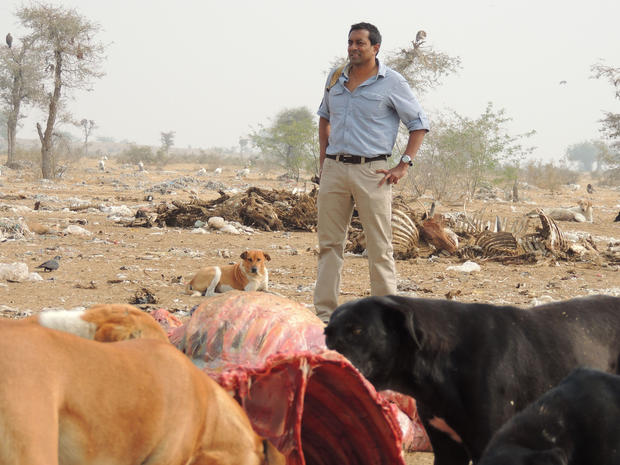In Indian carcass fields, pollution's impact takes unusual form
BIKANER, India In India cows are considered holy. They are not eaten, except by the Muslim and Christian minority but even then, in deference to the sentiments of the majority Hindu population, rarely so. Cattle are sighted in both the agricultural heartland and the burgeoning cities pulling the plow, driven before a cart, or simply foraging the streets at will. The milk they provide is a staple of Indian diets (paneer) and their dung is burned for fuel or used to cement up huts.
When cows die they are taken to open fields and left to the scavengers. Sometimes the hides are taken for leather but the meat is left alone. A couple of decades ago India had a huge population of vultures, eight species mostly from the genus Gyps, and they thrived by stripping the cow carcasses left in the fields down to the bone within a few frenzied minutes. Today, because of the huge decline in vulture numbers (over 99 percent for some species like the White-backed vulture) brought about by the widespread use of a veterinary anti-inflammatory drug, Diclofenac, which is deadly to vultures even in a single small dose, the disposal of a carcass is now problematic. Huge dumps have sprouted near urban centers where thousands of dead cows, along with the occasional horse or camel, are brought to rot or be fed upon by feral dogs, crows, and migrant raptors.
I recently visited one of these carcass dumps, a few hours drive from the famed "pink city" of Jaipur, in the desert state of Rajasthan. I estimated perhaps 5,000 visible carcasses spread over about 60 dusty acres. It is hard to tell amidst the jumble of bones, horns, and hide.
The decomposing bodies were an extraordinary sight, the stench tongue-coating and revolting -- yet one thing above all stood out for me: The entire field of carcasses was strewn with plastic -- long strips of it, often brittle, fragile, and invariably white, festooning like macabre party streamers the ribs and horns of dead animals.
In many places streamers of plastic and polyurethane were balled up into a slightly flattened sphere about the size of a plump pillow, one every three or four strides apart. The area was not a garbage dump. It was too far away from the city to conveniently transport rubbish, and I never saw anyone bring a card load of rubbish, so what had brought all this plastic out here?
And then it struck me -- it was the cows! What I was seeing was the stomach content of urban cows. Feeding on refuse and roadside grasses these cows routinely ingest a huge amount of rubbish, including those ubiquitous -- and non-digestible -- plastic bags. The sheer volume was terrifying and it was hard to imagine how these cows could not have suffered malnutrition from the massive amount of plastic they had ingested during their lives
Rajasthan, like other states in India, has banned plastic bags, but the law is openly flouted for the sake of necessity and convenience. And with a lack of investment in infrastructure, a growing and dense population, poor animal husbandry, and low public awareness, plastic bags are a more common a sight in Indian cities than greenery.
Walk through any urban area in India in the morning and you will see shopkeepers and home owners sweeping and sometimes washing the rectangular confines of their street-level businesses. But the refuse is not picked up and put into a bin but rather pushed onto the streets and the edges of the pavements. There is little in the way of public trash cans, little infrastructure devoted to sanitation, irregular garbage pickups, and very little social ostracizing of litterers. It's not that people want to litter, but you can only carry garbage in your hands for so long before you look for a place to get rid of it. Disney has worked out that in their amusement parks, 28 steps is about what it takes for an annoyed American parent to want to ditch litter.
Though I have become somewhat immune to the sight of garbage, seeing the remains of city life transported in the stomach of livestock was, to me, more shocking than the carcasses themselves. It was a reminder of the long impacts we have on our environment that go unnoticed and a sober reminder of the challenges of changing behavior and ingrained practices in societies where buying rather than responsibly disposing, is the driving force.
M. Sanjayan is the lead scientist for The Nature Conservancy and the CBS News science and environmental contributor. You can follow him on twitter at @msanjayan
More reports from M. Sanjayan:
